- Home
- Ricoh Global Newsroom
- Stories
- Portable Plastic Identification Sensor Embodies Ricoh’s Circular Economy Vision by Helping Resolve Plastic Waste Issue
Products & Services Portable Plastic Identification Sensor Embodies Ricoh’s Circular Economy Vision by Helping Resolve Plastic Waste Issue
- Sustainability
- Sustainability

Contents
- Much more room to step up plastics recycling. Social issues concerning waste plastic
- A potential boon for plastics recycling
- A proprietary optical device that is compact and simple to operate
- Easy classification accelerates waste plastic recycling
- A catalyst for educating kids
- A big picture view of a circular economy
Consumers and companies alike dispose of huge amounts of plastic every day. The destinations for too much of this material are incineration and landfill. These environmentally hazardous practices are global problems. The portable Ricoh Handy Plastic Sensor B150 could assist with recycling and help resolve these issues by identifying plastics.
Four Ricoh experts spoke with us about the development backdrop for this device and their goals for it. One was Tomohiko Kamaya, manager of the Circular Economy Solutions Development Department at the Environment & Energy Business Center. Two others were Hidetaka Noguchi, a leader in that office’s 3rd Development Section, and Tatsuya Takarada from the 3rd Planning and Project Management Section of that office. The fourth was Norihiko Tayama of the Product Support Section in the Business Promotion Department.
Much more room to step up plastics recycling. Social issues concerning waste plastic
Data from Japan’s Plastic Waste Management Institute shows that the nation generated 8.22 million metric tons of waste plastic in 2020, recycling about 7.09 million metric tons of that amount. Around 1.73 million metric tons was recycled into raw materials for plastic. About 270,000 metric tons was chemically converted into oil and other substances. A total of 5.09 million tons was thermally recycled—burning plastic for energy.
Takarada oversees marketing for the Ricoh Handy Plastic Sensor B150. He thinks that while Japan recycles more than 80% of its plastics, the penetration of recycled resins that pose less of an environmental impact is still low.
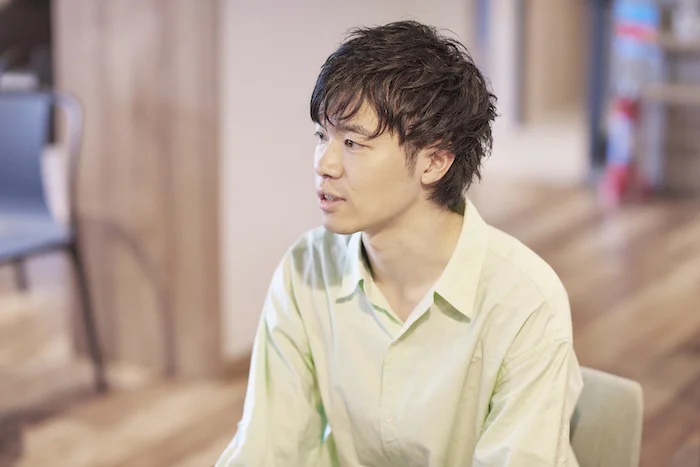
Tatsuya Takarada, 3rd Planning and Project Management Section, Circular Economy Solutions Development Department, Environment & Energy Business Center
He says that "While thermal recycling produces energy, it still harms the environment because it entails incineration. Materials and chemical recycling become impractical as these processes are expensive and require additional work and because it is hard to accurately classify plastics. Currently, plastics that are not classified are burned through thermal recycling."
Classification difficulties impede recycling. The Ricoh Handy Plastic Sensor B150 helps overcome this waste issue.
A potential boon for plastics recycling
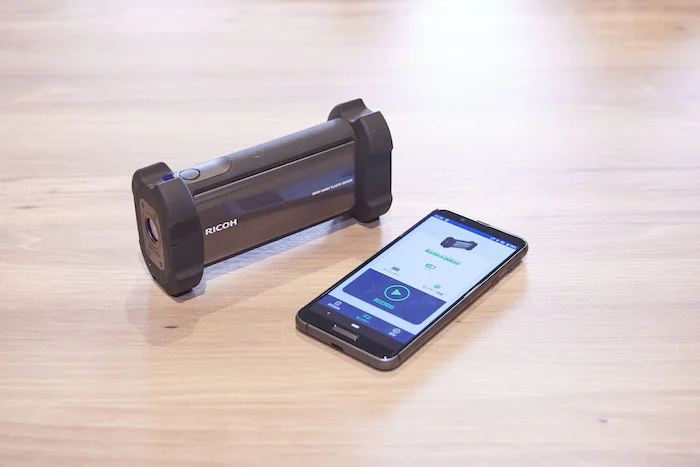
RICOH HANDY PLASTIC SENSOR B150
Ricoh developed its sensor to foster recycling plastics instead of burning them or otherwise disposing of them because of the classification difficulties. Its greatest feature is simple and lightning-fast operability. Just hold it over an object and press a button. A smartphone or tablet will show the results in just two seconds. The sensor fits comfortably in one hand, so you can take measurements anywhere just with this device and a smartphone.
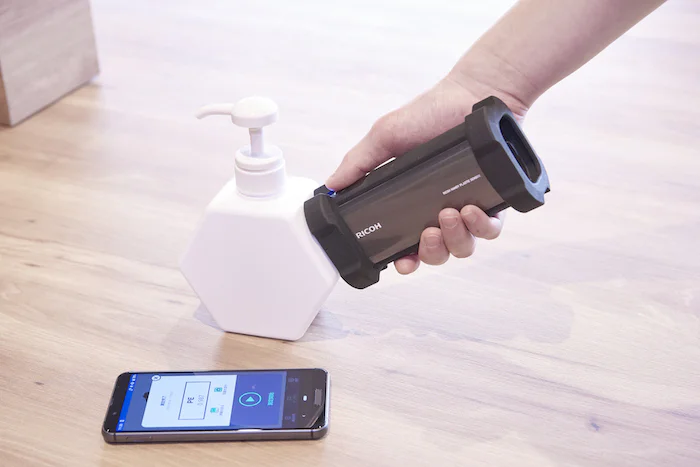
As of September 2022, this device was able to identify 13 types of plastic, representing more than 80% of Japan’s production of these materials. The user registration function allows users to name and save up to 100 measurements for materials that the device cannot identify.
Circular Economy Solutions Development Department of the Environment & Energy Business Center oversees Ricoh’s eco-related products. It developed the new sensor. The center is pivotal to the Ricoh Group’s quest, since formulating its Comet Circle concept in 1994, of materializing a circular economy, including by recycling products and parts.
Tomohiko Kamaya, who manages the center’s Circular Economy Solutions Development Department and leads the project for Ricoh’s sensor, says that "The Environment & Energy Business Center mainly undertakes new businesses that tackle environmental issues. My office designs products with a view to materializing a circular economy. We are deploying our plastics identification sensor to step up that commitment."
A proprietary optical device that is compact and simple to operate
The proprietary technology in this device originated with a large spectroscopic plastic identification sensor. Ricoh started developing its portable device in light of growing concerns worldwide about waste plastic, including as a result of China’s ban on importing this material. In 2021, Ricoh reached the prospect of commercializing this device and is currently conducting proof-of-concept tests for full-scale sales launch.
Two optical devices enabled Ricoh to develop the new sensor. One was the proprietary micro-electromechanical systems (MEMS) mirror. The other was a concave diffraction grating. Hidetaka Noguchi, who spearheaded the development of this technology, notes that, "The sensor is compact and simple to use."

Hidetaka Noguchi, 3rd Development Section leader, Circular Economy Solutions Development Department, Environment & Energy Business Center
He adds that, "This device’s mechanism is, near-infrared rays are shone on the object and the spectrum of light returned is measured to identify the material. Ricoh developed the MEMS mirror for copiers and automotive head-up displays. We applied that mirror to this sensor and combined it with a mirror-like concave diffraction grating derived from in-house precision molding technology. That enabled us to acquire spectral data with a single-element detector, miniaturizing the sensor and cutting costs."
Linking the sensor with smartphone and tablet apps was essential to user friendliness. Says Noguchi, "The sensor would be bigger and more expensive if it also incorporated a display. Compactness and simple operability were priorities when we embarked on development. The idea was that updating the user interface would improve materials classification processes and results displays. The sensor would only have to collect light data and send it to an app."
Easy classification accelerates waste plastic recycling
Prospective users of Ricoh’s sensor are waste plastics recycling firms, automakers, and manufacturers of electronics, foods, and other offerings that generate waste plastics in production processes.
There are numerous varieties of plastic, many of which are blended. Formulations often differ among plastic makers, hampering accurate classifications. Norihiko Tayama has heard a lot of opinions from frontlines sensor users in his marketing and sales strategy work. He told us about the challenges that companies face in dealing with waste plastics and the potential benefits from deploying sensors.

Norihiko Tayama, Product Support Section, Business Promotion Department
Tayama said that "In many cases, you see wholesale disposals of plastics owing to a lack of knowledge about their types and insufficient finances. Recycling firms find sorting plastics hard when they do not know what they’re made of. Seasoned workers may even set them on fire to get clues from the color of the flame or odor. Ricoh’s portable sensor makes it easy for anyone, irrespective of experience, to accurately identify plastics. It opens the door to reusing waste plastics that would normally be discarded."
Recycling firms taking part in proof-of-concept testing have admired the sensor’s portability. Tayama recalls that, "One firm wanted a device that salespeople could take to customer sites when buying waste plastics. If they could instantly identify the material, they could provide estimates on the spot. That could generate new business opportunities. There are high hopes for this tool to improve sales efficiency."
Ricoh’s sensor also resolves waste disposal issues for manufacturers. Some proof-of-concept test participants reported that they were able to cut disposal costs by recycling valuable plastic that they would have otherwise discarded. Another key benefit is that the sensor could enable companies to meet their corporate social responsibilities by tackling the environmental issues that increasingly worry consumers.
A catalyst for educating kids
Ricoh is leveraging the sensor to educate about waste plastics. It is enabling members of the public use the device in local environmental projects, student events, and sightseeing tours. For the Sea and Japan Project in Obama City, Fukui Prefecture, elementary school students used the sensor to identify the plastics in marine debris they collected, sorting items accordingly.
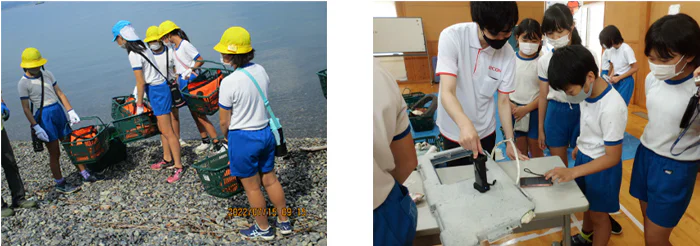
Takarada says that "The children enjoyed this experience because the sensor is so easy to use. Kids can be brutally honest, so when unable to identify a plastic, they would get frustrated. In such cases, I would tell them that materials in bags might be difficult to recycle and that we should all do our best to avoid generating too much waste. They would readily understand. It would delight me to interest more children in the issue of waste plastics through events."
A big picture view of a circular economy
Noguchi has developed sensor technology over many years. He looks toward what will happen after the sensor’s formal release. He says that "It is still hard to distinguish between dark resins and those with multiple layers of raw materials. We will keep refining our technology so that it can identify more plastics. Also, it’s important to note that households generate around half of all plastic wastes. While we developed our sensor for industrial use, we’d like to create an affordable model that people can use at home. We’d therefore employ our development approach of listening carefully to customer needs and reflecting feedback in our product."
Many companies taking part in proof-of-concept tests have indicated that they want something that can identify more types of plastic. Takarada looks forward to leveraging field feedback to make improvements.
He says that "I think it would be great for people to habitually sort plastics with a portable sensor. We also look forward to bringing out a large, more precise device to foster full-scale sorting. If that happens in conjunction with compliance with a plastic resources recycling law that went into effect in April 2022, we look to see more materials recycling. I hope that our sensor will be a wakeup call for those who find recycling pointless, because they think that it takes a lot of time and money and the quality of recycled materials low."
Tayama looks for the sensor to help users learn more about plastics. He says that "I think this device will encourage companies, adults, and children to act differently, minimizing their plastics usage or maximizing their use of single-material plastics. I hope that my involvement in this product can contribute in some way to resolving social issues."
Tomohiko Kamaya, manager of Circular Economy Solutions Development Department at the Environment & Energy Business Center, hopes that the Ricoh Handy Plastic Sensor B150 can serve as a platform for the company to step up efforts to help materialize a circular economy. He says that "Ricoh will continue working on the big picture of a circular economy with this product. We will first of all ensure global uptake so we can proudly say that we’ve made a contribution. We’ll then collaborate with business partners to do even more because we know we cannot achieve alone."
By opening new vistas for plastics recycling, Ricoh will accelerate its quest to help materialize a truly circular economy.
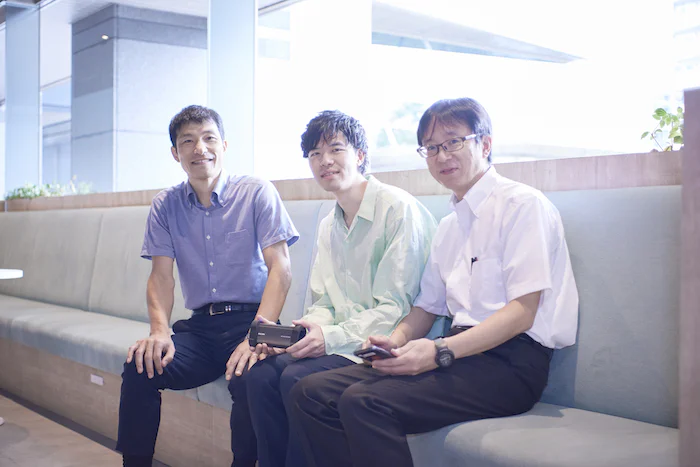
Related Articles
Products & Services
Related Articles
#Sustainability
- Home
- Ricoh Global Newsroom
- Stories
- Portable Plastic Identification Sensor Embodies Ricoh’s Circular Economy Vision by Helping Resolve Plastic Waste Issue









